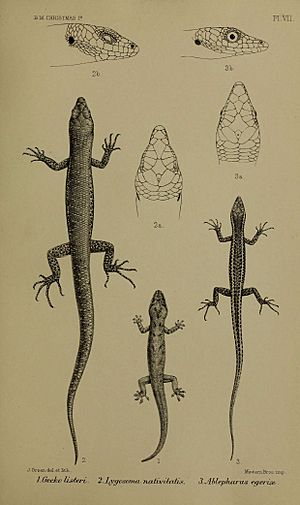Christmas Island blue-tailed shining-skink facts for kids
Quick facts for kids Christmas Island blue-tailed shining-skink |
|
|---|---|
 |
|
| This picture from 1900 shows three Christmas Island reptiles. The Christmas Island blue-tailed skink is on the right. | |
| Conservation status | |
| Scientific classification | |
| Genus: |
Cryptoblepharus
|
| Species: |
egeriae
|
| Synonyms | |
|
|
The Christmas Island blue-tailed skink (scientific name: Cryptoblepharus egeriae) is a small lizard. It is also known as the blue-tailed shining-skink. This skink used to live only on Christmas Island. It was discovered in 1888.
For a long time, it was the most common reptile on the island. Many skinks lived near human homes. But in the early 1990s, their numbers started to drop quickly. This happened after a new snake and the yellow crazy ant (Anoplolepis gracilipes) arrived on the island.
By 2006, the Christmas Island blue-tailed skink was on the endangered list. By 2010, it was extinct in the wild. This means it no longer lived freely in nature. Luckily, from 2009 to 2010, Parks Australia and Taronga Zoo started a special breeding program. This program has helped save the species from disappearing completely.
Contents
About the Christmas Island Blue-tailed Skink
The Christmas Island blue-tailed skink is a small lizard. It usually grows to be about 4 to 5 centimeters (1.5 to 2 inches) long. This measurement is from its snout (nose) to its vent (the opening near its tail).
You can easily spot this skink. It has a small black body with two yellow stripes. These stripes run down its back. Its tail is a bright, beautiful blue color. This bright tail helps the skink escape from danger. If a predator tries to catch it, the skink can drop its tail. The bright blue tail distracts the predator, letting the skink get away safely.
What Does the Skink Eat?
The Christmas Island blue-tailed skink is an insectivore. This means it mostly eats insects. It is a forager, which means it searches for its food.
Its favorite foods include crickets, beetles, flies, grasshoppers, spiders, and earthworms. Sometimes, it might eat a little bit of vegetation. But insects are its main food source. Because it is so small, the skink looks for food on the ground. It also finds food on exposed rocks and low plants. It usually only eats prey that moves slowly.
How Do Skinks Reproduce?
Christmas Island blue-tailed skinks start to breed when they are about one year old. In the wild, they usually live for about seven years. They can breed for six of those years.
When a male skink wants to find a mate, he will do a special courtship dance. Female skinks release special smells called biochemicals. These smells let the males know when the female is ready to have babies. Male skinks often fight each other to win a female mate during breeding season. These skinks are polygamous, meaning they can have many partners. This helps them have more babies.
After a female skink is fertilized, she lays eggs. She is oviparous, which means she lays eggs instead of giving birth to live young. She usually lays two eggs at a time. The eggs take about 75 days to hatch.
Where Do These Skinks Live?
Until the late 1990s, the Christmas Island blue-tailed skink was endemic to Christmas Island. This means it lived only there. You could find them all over the island.
Now, they only exist in special groups. Some are on Christmas Island itself. Others are at Taronga Zoo in Australia. Some have also been moved to a small island called Pulu Blan. This island is part of the Cocos (Keeling) Islands. This move is an assisted colonization trial. It's a way to help the skinks survive in a new, safe place.
Saving the Skinks
The main reason these skinks almost disappeared was because of new animals. A predatory wolf snake and the yellow crazy ant were accidentally brought to Christmas Island in the 1980s. These new species caused a lot of problems for the skinks.
Even though the Christmas Island blue-tailed skink is now extinct in the wild, there's hope! Taronga Zoo has a very active breeding program. This program started with 66 skinks that were saved before their population was wiped out. The breeding program has been running for over ten years. Its main goal is to release some of the skinks back into their natural home.
Thanks to these efforts, over 300 skinks have already been moved to the Cocos (Keeling) Islands. Scientists also studied the skink's DNA in 2022. They found that the skinks used to have a lot of different genes. This means there were many skinks in the past. But they also found signs of recent inbreeding. This likely happened because the skinks used for the breeding program were related.
See also
- List of reptiles of Christmas Island


